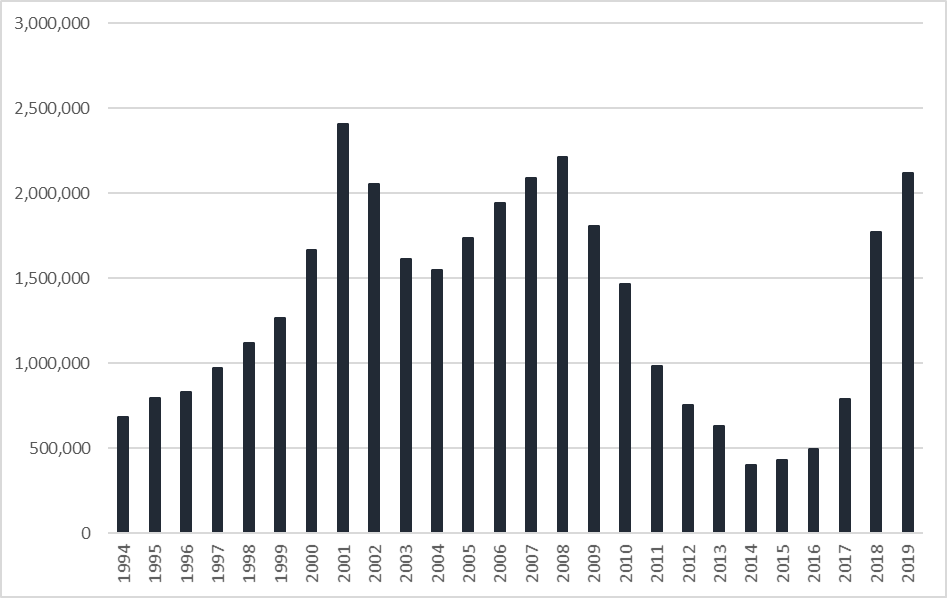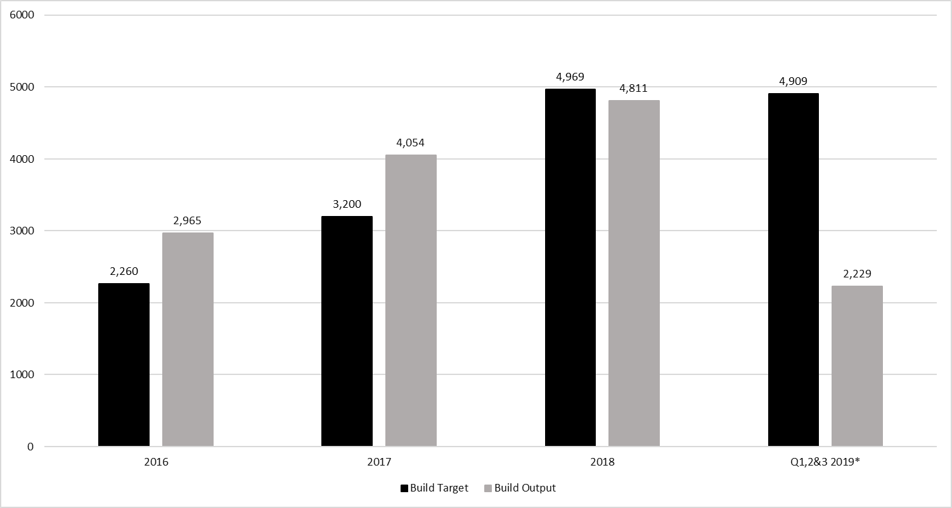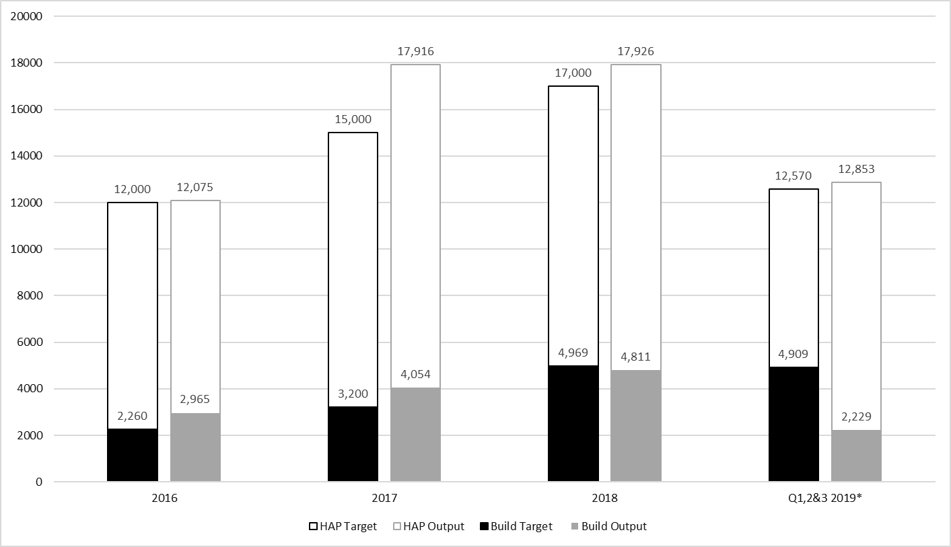Affordable Housing, not housing subsidies, needed to addressing Housing Crisis

Chart 1 shows the pro-cyclical nature of central government capital expenditure allocations to the Department of Housing, Planning and Local Government since 1994. Expenditure increased steadily from 1994 to 2000, before declining sharply. A further period of increase between 2004 and 2008 was followed by another, more severe decline in the years 2009 to 2015. Since then, gross capital expenditure allocation has increased again, however the volatile nature of this expenditure pattern calls into question the sustainability of any long-term capital projects.
Chart 1: Gross Capital Expenditure on Housing, 1994 to 2019, €,000

Source: Department of Public Expenditure and Reform, Databank
According to the Rebuilding Ireland Targets and Progress Report, the target to provide 47,000 social housing units has been revised to 50,483 (Pillar 2), of which just 25,623 had been delivered through builds, acquisition and leasing up to Q3 2019. Just 42 per cent of the total build target of 33,617 has been met to Q3 2019 (Chart 2), with targets missed for 2018 and up to the last reported quarter. It is interesting to note that the acquisition target for the whole programme has already been exceeded (the target to 2021 was for the acquisition of 6,830 units, as of Q3 2019, 8,314 units had been acquired). Speed of delivery is likely a contributing factor, however in many areas this would be a more expensive form of housing provision compared to direct builds by Local Authorities and Approved Housing Bodies, particularly if using State lands. The continuing cost to the Exchequer must also be a factor in determining the best method and it is time that a full comparative long-term cost analysis is developed.
Chart 2: Social Housing Builds v Targets, 2016 to Q3 2019

Source: Rebuilding Ireland – Targets and Progress, Department of Housing, Planning and Local Government
Note: Target for Q3 2019 is calculated by multiplying the full year target for 2019 by 75%
In early 2019, the Department of Housing, Planning and Local Government published a breakdown of Social Housing Output for 2018 by local authority area. This showed that 45 per cent of all Local Authorities failed to meet their build targets in 2018, with Galway City Council only providing a quarter of its target builds and Westmeath County Council providing just over a third. The Housing Assistance Payment (HAP), a subsidy to landlords in the private rented sector, continued to outpace the provision of long-term sustainable homes, accounting for 66 per cent of all Social Housing Output in the reporting period.
The numbers acquired and leased, compared to the targets set in this area, fared better in terms of targets reached. Here, targets were exceeded in all but 8 Local Authority areas. Actual Acquisitions and Leases in most areas which exceeded targets were 100-250 per cent of target, with Offaly being over 550 per cent, albeit from a low target of 14. In terms of the actual number of units provided through this method, more social housing units were provided through Acquisitions and Leasing than actual builds (including Regeneration) in 14 of the 31 Local Authority areas.
The proportion of Social Housing Output attributed to HAP can be as much as 86 per cent, with those Local Authorities at the lower end of the scale still providing almost half of their social housing through this method. It is interesting to note that Galway City Council, which met the smallest proportion of its build target (just 25 per cent), had the highest proportion of Social Housing Output attributed to HAP.
Recent Government policy has seen a shift away from the construction of social housing to an over-reliance on the private rented sector to provide social housing ‘solutions’. This is evident from both the increase and change in nature of the current expenditure on housing in recent years. According to a report prepared by the Irish Government Economic and Evaluation Service (IGEES) for the Department of Public Expenditure and Reform, from 2006 to 2017 Rent Supplement was the main area of current housing expenditure. While the proportion attributed to the Rental Accommodation Scheme (RAS) was growing steadily during this period, the introduction of the Housing Assistance Payment (HAP) in 2014 has had the greatest impact on the distribution of current housing expenditure.
Ostensibly, the introduction of HAP was to provide a longer-term supplementary payment for the growing number of private tenants in receipt of Rent Supplement for longer than its intended duration. Since 2014, the importance of HAP as a means of providing ‘social housing supports’ increased dramatically, and it was the cornerstone of Rebuilding Ireland’s “social housing solutions” (Chart 3). HAP is a payment made by the local authority directly to the landlord in respect of a household assessed as needing long-term social housing. The tenancy is between the landlord and the tenant, and notwithstanding the introduction of anti-discrimination laws in favour of tenants in receipt of HAP, choosing to accept, and retain, HAP tenants in a time of double-digit rent inflation remains at the discretion of the landlord.
Chart 3: Social Housing (builds) and HAP, Targets v Output, 2016 to Q3 2019

Source: Rebuilding Ireland – Targets and Progress, Department of Housing, Planning and Local Government
Note: Target for Q3 2019 is calculated by multiplying the full year target for 2019 by 75%
The decline in local authority construction, discretionary nature of HAP tenancies, increase in the cost of private rents and the promotion by Government of policies which seek to rely on the private rented sector for the provision of social housing places low-income households in precarious living situations. It is also a considerable cost to the Exchequer, with Local Authority Budgets for 2019 anticipating an expenditure of €545 million for the year[1].
Government should aim to emulate our European peers who perform well in terms of social housing provision and social housing stock. Social Justice Ireland proposes that Government set a target of 20 per cent of all housing stock in Ireland to be social housing and substantial progress to this target should be made in a 5-year programme for Government. Progress updates and reports should be presented annually to the Oireachtas.
[1] https://www.housing.gov.ie/sites/default/files/publications/files/final_...

GIVING A VOICE TO THOSE
WHO DON’T HAVE A VOICE
When you support Social Justice Ireland, you are tackling the causes of problems.
